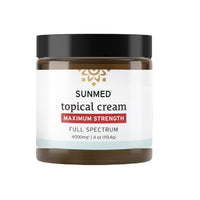Study finds flavonoids, terpenes, and cannabinoids work synergistically to reduce inflammation markers

Medically Reviewed by: Dr. Caley Scott, ND
If you're familiar with CBD, you may already know it's revered for its potential wellness benefits. But now, there's even more reason to consider this remarkable compound.
A new study validates what many researchers already suspected: cannabinoids, flavonoids, and terpenes found in the Cannabis sativa plant, more commonly known as hemp or cannabis, can work synergistically to support our overall health – specifically in terms of inflammation markers.
This fascinating discovery offers a deeper understanding of how these bioactive compounds interact with our body's complex cell-signaling system, the endocannabinoid system (ECS), potentially influencing a wide array of physiological processes, including immune health and pain signaling.
What are cannabinoids?
Cannabinoids are naturally occurring compounds found in hemp and cannabis plants. They are part of a class of diverse chemical compounds that act on cannabinoid receptors in cells. The chemical makeup of cannabinoids allows them to have a direct or indirect influence on the receptors of the ECS, impacting various physiological processes.
There are over 100 known cannabinoids in the Cannabis sativa plant, but the most studied and understood are CBD and THC. CBD (cannabidiol) is non-psychoactive, meaning it doesn't produce the “high” associated with cannabis use. Instead, it's being studied for potential therapeutic uses, including its potential anti-inflammatory properties.
On the other hand, THC (tetrahydrocannabinol) is the main psychoactive compound in cannabis that produces a “high” sensation.
What is the endocannabinoid system?
The endocannabinoid system (ECS) is a complex cell-signaling system that was identified in the early 1990s during research into THC, a well-known cannabinoid.
The ECS is involved in regulating a variety of functions and processes. These include sleep patterns, mood swings, appetite, and memory, among others. Beyond these, the ECS also plays a crucial role in homeostasis — the state of steady internal, physical, and chemical conditions maintained by living systems. Basically, homeostasis is the state of balanced regulation necessary for maintaining health and life.
To put it simply, the ECS is your body's way of keeping everything balanced — not too much, not too little, but just right.
How can cannabinoids work with the ECS?
Cannabinoids, including CBD and THC, have a molecular structure similar to endocannabinoids, the cannabinoids that our bodies naturally produce. This similarity allows cannabinoids to interact with the ECS, potentially influencing a variety of physiological processes.
THC, for example, binds with the CB1 receptors, particularly abundant in the brain, to produce a high. CBD, on the other hand, has a different way of interacting with the ECS. It doesn't bind directly with the CB1 or CB2 receptors. Instead, it's believed to work more subtly by inhibiting an enzyme called FAAH, which breaks down anandamide.
Anandamide is an endocannabinoid often referred to as the bliss molecule due to its role in generating feelings of happiness and well-being. By inhibiting FAAH, CBD may help to prolong the effects of anandamide, potentially promoting feelings of well-being and relaxation.
Understanding cannabinoids and their interaction with the ECS provides valuable insights into the potential health benefits of cannabis and hemp-derived products. As research continues to evolve, we can further understand and tap into the therapeutic potential of these remarkable compounds. This knowledge holds the promise of harnessing the power of cannabinoids to promote health and well-being.
What are inflammation markers?
Inflammation markers, also known as inflammatory markers, are substances the body produces in response to inflammation. They are a key part of the immune system's response to injury, infection, diseases, or autoimmune conditions like arthritis.
These markers can be proteins, cytokines, or enzymes that increase or decrease in quantity due to inflammation. Doctors often measure the levels of certain inflammation markers in the blood to determine if inflammation is present in the body and if so, to what extent.
Two common inflammation markers that doctors often measure are C-reactive protein (CRP) and erythrocyte sedimentation rate (ESR). High levels of CRP in the blood can indicate inflammation from conditions such as infections, autoimmune diseases, and cancer. Similarly, a high ESR can also indicate inflammation, but the test doesn't pinpoint the cause of the inflammation.
It's important to note that while inflammation is a natural and necessary response to protect the body, chronic inflammation can lead to various health problems. Therefore, understanding and monitoring inflammation markers can play a crucial role in managing overall health and wellness.
How does cannabis impact inflammatory markers?
According to the study, the cannabis plant exhibits significant potential in managing inflammatory markers due to the diverse bioactive compounds it hosts, such as cannabinoids, terpenes, and flavonoids.
Cannabinoids
Cannabinoids, mainly cannabidiol (CBD) and tetrahydrocannabinol (THC), have gained attention in scientific literature due to their direct interaction with the endocannabinoid system in the human body.
The body's endocannabinoid system plays a crucial role in managing inflammation, a key part of our body's response to injury or infection. Research has found that during inflammation, certain natural compounds called endocannabinoids are produced in large amounts by different types of cells in the body, such as microglia, macrophages, astrocytes, and neurons. These endocannabinoids then attach to specific receptors in the body, called CB1 receptors, and might help reduce damage to nerve cells.
The study looked at how CBD, a cannabinoid found in cannabis, can affect inflammation. It found that CBD treatment reduced the levels of various markers of inflammation, like IL-6, TNF-α, COX-2, and iNOS, especially in the brains of newborn mice that had experienced a lack of oxygen and blood flow. This effect seems to involve other receptors in the body, such as CB2 and adenosine A2A receptors.
CBD also specifically affects a receptor called GPR55 in certain immune cells. By inhibiting this receptor, CBD can lower the production of TNF-α, a compound that causes inflammation. Studies using rat retinas showed that CBD treatment reduced inflammation and prevented certain types of immune cells from accumulating and causing damage.
THC, another cannabinoid, has also been found to have anti-inflammatory properties. It increases the production of anti-inflammatory molecules while decreasing the production of pro-inflammatory ones. Additionally, THC can induce cell death in specific immune cells involved in inflammation and boost the population of regulatory T cells, which help control the immune response.
Another cannabinoid called Δ9-tetrahydrocannabivarin (THCV) has shown promise in animal studies for its ability to partially activate CB1 and CB2 receptors and reduce seizures.
Both THC and CBD have shown significant potential in managing neuroinflammation, but the exact mechanisms through which they exert their anti-inflammatory actions aren’t yet fully understood.
Terpenes
Terpenes are aromatic compounds found in many plants, including hemp and cannabis. They give these plants their unique scent and flavor, and there are approximately 200 unique terpenes found in cannabis.
Terpenes can interact with various bodily targets such as neurotransmitter receptors, enzymes, cell membranes, and more. They can work independently and synergistically with cannabinoids, enhancing various therapeutic effects, including penetrating the blood-brain barrier and aiding the binding of THC to CB1 receptors.
Terpenes also contribute to the plant's therapeutic properties. For instance, some terpenes are known to promote relaxation and stress relief, while others promote focus and acuity.
These compounds have shown potential pharmacological properties, including the ability to interact with neurotransmitter receptors, enzymes, and cell membranes, often playing a role in enhancing or modulating the effects of cannabinoids. This interactive relationship suggests a synergy that leads to additive or increased therapeutic effects — a concept known as the “entourage effect.”
Myrcene, commonly found in fragrant plants, is well-known for reducing inflammation, alleviating pain, and promoting relaxation. Alpha-pinene, another compound found in various plants, has antioxidant and anti-inflammatory properties, indicating potential benefits for conditions like osteoarthritis. Interestingly, it can also counteract the memory impairment sometimes caused by THC.
Linalool, a type of monoterpene, possesses anti-ischemic (protecting against reduced blood flow), antioxidant, and anti-inflammatory properties. It helps protect nerve cells from oxidative damage and prevents inflammatory reactions in immune cells like macrophages and microglia.
Limonene, another monoterpene, has notable anti-inflammatory and antioxidant effects. It has been shown to reduce inflammation in different experimental models and enhance the activity of antioxidant enzymes in the central nervous system.
Flavonoids
Flavonoids are another class of compounds in cannabis thought to provide health benefits through cell signaling pathways and antioxidant effects. They are responsible for the vivid colors of fruits and vegetables. In hemp and cannabis, flavonoids contribute to the aroma, taste, and color of the plant. Although studies on cannabis flavonoids are still in their early stages, initial findings have pointed to their anti-inflammatory and antioxidant properties.
Three flavonoids — cannflavin A, B, and C — have been identified in cannabis, showing particularly promising therapeutic properties as anti-neuroinflammatory agents.
In research from the 1980s, it was discovered that these cannflavins were about 30 times more potent than aspirin at inhibiting the release of prostaglandin E2, a compound involved in inflammation, from human rheumatoid synovial cells in excised tissue experiments. However, more research is needed.
What is the entourage effect?
The entourage effect is a theory that all the compounds in cannabis work together, and when taken together, they produce a better effect than when taken individually. This synergistic interplay between cannabis compounds involves cannabinoids, flavonoids, and terpenes.
The idea behind the entourage effect is that the combined effects of cannabinoids, flavonoids, and terpenes can be greater than the sum of their individual effects. They can enhance each other's chemistry, making the whole plant more effective in addressing discomfort and inflammation.
This theory has been around for some time, but it's now being validated by recent groundbreaking studies. They show that the different parts of the cannabis plant may work synergistically with immune markers. This synergy could potentially enhance the plant's effects, making it a promising area for future research and a possible game-changer in the realm of natural health products.
How to get the most out of your CBD use
Getting the most out of your CBD use involves understanding the different types of CBD and how they interact with your body. Full spectrum CBD is considered the most effective due to the entourage effect.
Full spectrum CBD contains a trace amount of THC, not enough to cause a high but sufficient to amplify the overall benefits of CBD. These products are carefully extracted from organic hemp biomass and are third-party tested quality, safety, and accuracy.
Consistency is key when using CBD, especially for managing everyday feelings of tension or discomfort. Regular use can help maintain a steady level of CBD in your system, enhancing its potential benefits.
Matching the CBD product to your desired effect is also important. For instance, CBN gummies could be a good choice before bed, considering their potential to improve sleep quality. A topical product could offer localized, fast-acting relief for physical discomfort, while full spectrum tinctures could provide full-body support and potentially aid immune function.
Understanding your needs and how different CBD products work can help you get the most out of your CBD use. Always remember to start with a low serving size and adjust as needed, and ensure you're using your CBD products consistently for the best results.
The bottom line
As we consider the recent study and the synergy between cannabinoids, flavonoids, and terpenes, it’s no surprise that adding full spectrum CBD to your routine could help manage discomfort, support immune function, and promote overall wellness. Whether it's full spectrum CBD oil for comprehensive support, tasty gummies for easy consumption, or topical products for localized application, the key is to find what suits your needs.
The synergistic interplay of cannabinoids, flavonoids, and terpenes in full spectrum CBD could potentially enhance the overall benefits, making it a promising choice for those seeking a natural wellness supplement.
Sources:
Cannabinoid - an overview | ScienceDirect Topics
An introduction to the endogenous cannabinoid system | PMC
Brain activity of anandamide: a rewarding bliss? | PMC












